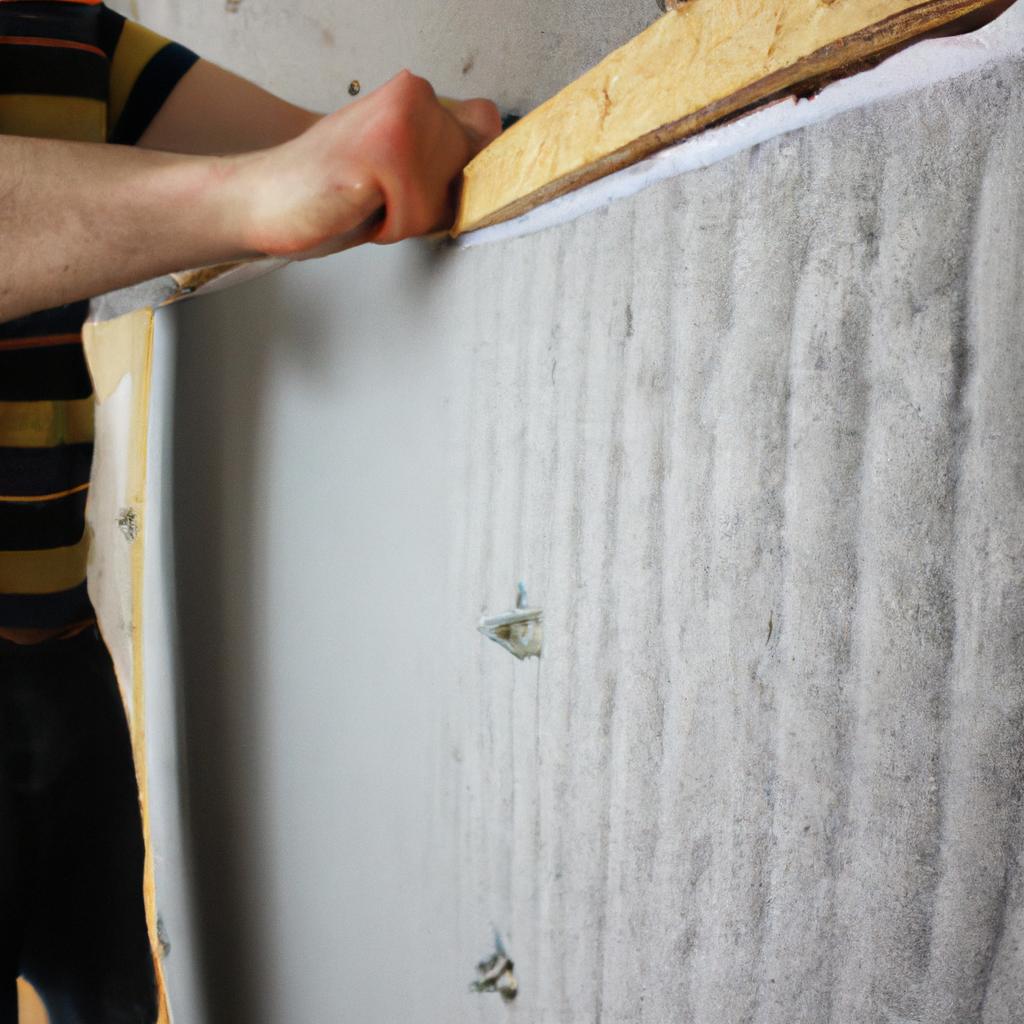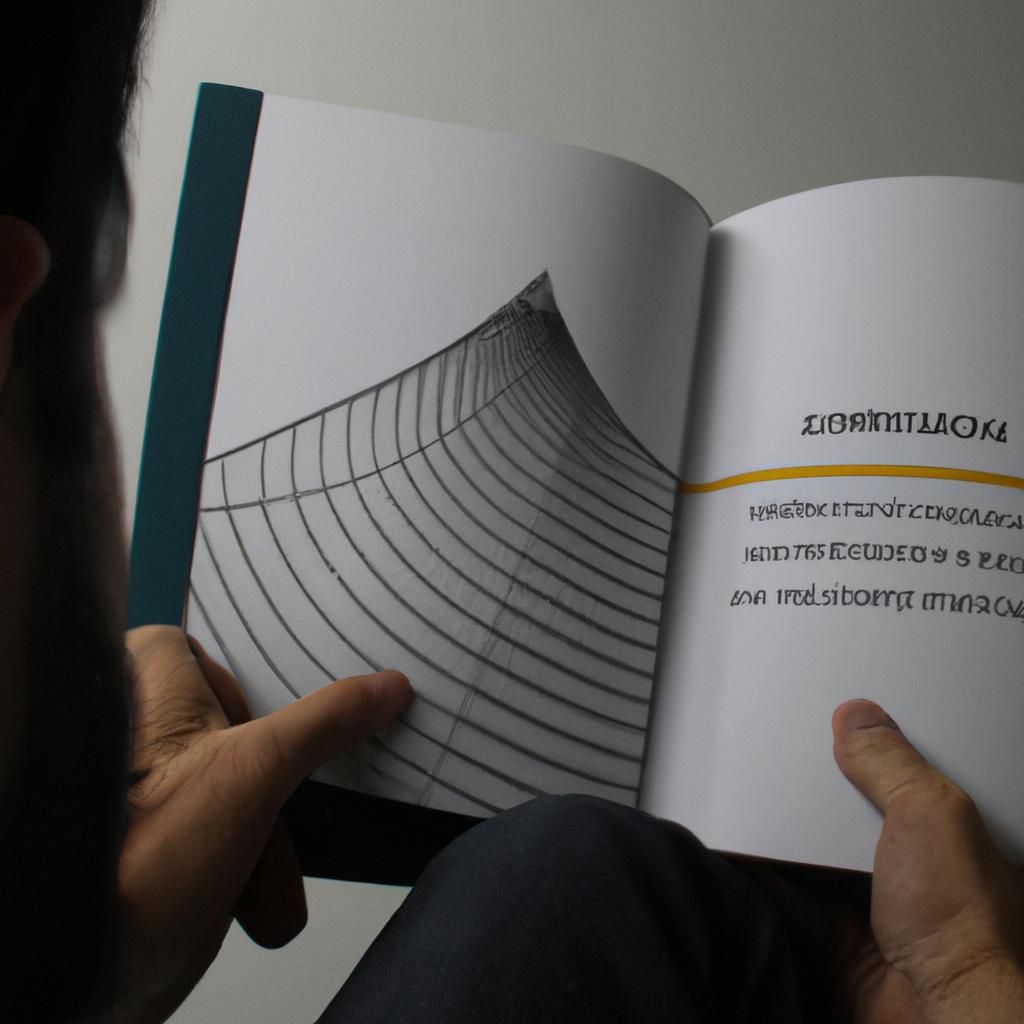In today’s fast-paced and interconnected world, the issue of noise pollution has become increasingly prevalent. Whether it be in residential areas, office spaces, or even public venues such as libraries or concert halls, unwanted sound can have a detrimental impact on our well-being and productivity. One particular scenario that highlights the need for effective soundproofing techniques is Sonic Loans, a fictitious financial institution facing significant challenges due to excessive noise levels within its call center. This article aims to explore various soundproofing methods that can be employed by Sonic Loans and similar organizations to mitigate the negative effects of noise pollution.
The case study of Sonic Loans serves as an apt example of how disruptive noise can hinder communication and overall operational efficiency within a business setting. In this fictional context, employees at the call center are frequently interrupted by external noises such as nearby construction work, traffic sounds, and conversations from neighboring offices. As a result, customer calls are often compromised by background distractions, leading to reduced customer satisfaction and potential loss of revenue for the company. It is crucial for businesses like Sonic Loans to address these challenges head-on through the implementation of soundproofing techniques specifically tailored to their unique working environment. By doing so, they can create a quieter workspace conducive to focused work and enhanced customer satisfaction.
One effective soundproofing method that Sonic Loans can consider is the installation of acoustic panels or sound-absorbing materials on the walls and ceilings of their call center. These panels are designed to absorb and reduce the transmission of sound waves, thereby minimizing echoes and reverberations within the space. By strategically placing these panels in areas where noise intrusion is most prominent, such as near windows or shared walls with neighboring offices, Sonic Loans can significantly decrease the impact of external noises on their employees’ ability to concentrate and communicate effectively.
Additionally, Sonic Loans can explore the option of using soundproof curtains or blinds for their windows. These specialized window treatments have built-in noise-blocking properties that help to create a barrier against external sounds. By investing in high-quality soundproof curtains or blinds, Sonic Loans can effectively minimize disturbances caused by traffic noise or nearby construction activities.
Furthermore, implementing desk dividers or cubicles with soundproofing materials can be beneficial in reducing cross-talk between employees within the call center. This not only helps improve individual focus but also prevents conversations from spilling over and disrupting others nearby.
In terms of technological solutions, Sonic Loans may want to consider upgrading their communication equipment to include noise-cancelling headsets for their employees. These headsets use advanced technology to actively neutralize background noises, allowing staff members to hear customers more clearly without distractions.
Lastly, conducting a thorough assessment of the call center’s layout and identifying potential sources of noise leakage is essential. By sealing gaps around doors and windows, installing weatherstripping or door sweeps, and addressing any structural weaknesses that allow sound transmission, Sonic Loans can further enhance their soundproofing efforts.
In conclusion, addressing excessive noise levels in environments like Sonic Loans’ call center requires a multi-faceted approach encompassing both physical modifications and technological upgrades. By implementing measures such as acoustic panels, soundproof curtains/blinds, desk dividers/cubicles with soundproofing materials, noise-cancelling headsets, and addressing structural weaknesses, Sonic Loans can create a quieter workspace that promotes productivity and customer satisfaction.
Understanding Sound Transmission
Imagine a scenario where you are in the comfort of your home, trying to relax after a long day at work. Suddenly, you hear the loud noise of construction machinery from outside. Despite being indoors and several walls away from the source of the sound, it still manages to disturb your peace. This example highlights the phenomenon of sound transmission and its impact on our daily lives.
Understanding how sound travels and is transmitted through various mediums is crucial when considering effective soundproofing techniques. Sound can travel through solids, liquids, and gases by creating vibrations that propagate as waves. In the context of building structures like Sonic Loans offices or apartments, these waves can be transmitted through different pathways such as airborne transmission, structural vibration, or flanking paths.
To provide a comprehensive understanding of sound transmission, consider the following bullet points:
- Airborne transmission: This refers to sound waves traveling directly through air spaces between rooms or buildings.
- Structural vibration: When sound energy causes objects within a structure to vibrate and transmit the noise further.
- Flanking paths: These are indirect routes that allow sounds to bypass conventional barriers via ductwork, ceiling voids, or wall cavities.
- Impact insulation class (IIC): A measure used to evaluate a floor assembly’s ability to reduce impact noise transmission.
To illustrate this further, refer to Table 1 which demonstrates different materials commonly found in construction projects along with their corresponding STC ratings (Sound Transmission Class). The STC rating quantifies how well a material reduces airborne sound transfer between two adjacent spaces – higher values indicate better performance.
| Material | STC Rating |
|---|---|
| Concrete | 50 |
| Double brick | 45 |
| Fiberglass | 35 |
| Single glass | 25 |
By comprehending these concepts and factors related to sound transmission, we can now delve into the process of identifying noise sources. Understanding how sound travels and what materials are more effective in reducing its transmission will serve as a foundation for developing appropriate soundproofing techniques specific to Sonic Loans’ environment.
Identifying Noise Sources
In the previous section, we explored the concept of sound transmission and its various factors. Now, let’s delve into identifying noise sources in order to effectively address them.
Imagine a scenario where you are trying to concentrate on your work at home while a neighbor is playing loud music next door. This intrusive noise can significantly disrupt your productivity and focus. Identifying the source of this noise is crucial for implementing appropriate soundproofing techniques.
To successfully identify noise sources, consider the following:
-
Conduct a thorough inspection: Start by inspecting your surroundings to pinpoint potential sources of noise. Look for any obvious culprits such as open windows, thin walls, or poorly insulated doors that may allow sound to enter your space.
-
Use technology: Employ sound level meters or smartphone applications specifically designed for measuring decibel levels. These tools will help you determine which areas in your environment produce excessive noise.
-
Seek professional advice: If you’re unable to locate the exact source of the noise or need assistance with advanced measurement techniques, consult an acoustic engineer or specialist who can provide expert guidance tailored to your specific situation.
Identifying noise sources lays the foundation for finding effective solutions to minimize unwanted sounds within your space. By understanding where these noises originate from, you can now move forward towards implementing suitable soundproofing techniques.
Sealing Air Leaks
Section H2: Sealing Air Leaks
In the previous section, we discussed the importance of identifying noise sources when soundproofing a space. Now, let’s move on to another crucial aspect of effective soundproofing: sealing air leaks. By addressing these gaps and cracks, you can significantly reduce the amount of noise that enters or escapes your environment.
To understand the impact of sealing air leaks, consider this hypothetical scenario: Imagine you are in an office building located near a busy street. Despite having installed soundproof windows, you still notice persistent external noises disrupting your work environment. Upon closer investigation, it becomes evident that small openings around doors and windows allow sound waves to infiltrate the room. Addressing these air leaks could provide a noticeable improvement in reducing external noise distractions.
When it comes to sealing air leaks for optimal soundproofing results, consider implementing the following techniques:
-
Caulking or Sealant Application:
- Apply caulking or sealant along door frames and window edges to close any gaps.
- Use weatherstripping tape or foam strips to seal spaces between movable parts like doors and windows.
-
Insulation:
- Install insulation materials such as fiberglass batts or spray foam insulation within walls and ceilings.
- Make sure all wall cavities are properly insulated to minimize sound transmission through them.
-
Acoustic Putty Pads:
- Place putty pads behind electrical outlet covers and light switches to prevent sound leakage through these areas.
- Ensure that all wall-mounted fixtures are securely sealed with acoustic putty pads.
-
Door Sweeps:
- Attach door sweeps at the bottom edge of doors to create a tight seal against the floor.
- Opt for automatic door bottoms for better efficiency in blocking airborne sounds from entering or exiting rooms.
By employing these methods to seal air leaks effectively, you can enhance the overall effectiveness of your soundproofing efforts. However, it is important to note that each soundproofing project may require a custom approach based on the specific needs and characteristics of the space.
These versatile panels can be an excellent addition to any soundproofing strategy, providing effective noise absorption while enhancing the aesthetic appeal of your environment.
Using Acoustic Panels
Section H2: Sealing Air Leaks
In the previous section, we discussed the importance of sealing air leaks as a fundamental step in soundproofing techniques for Sonic Loans. Now, let’s explore another effective method that can greatly enhance the sound insulation of your space.
One example of the impact air leaks can have on soundproofing is in a typical office environment. Consider an open-plan office with several cubicles where employees are constantly engaged in phone conversations or collaboration. Even with the use of partitions between workstations, sound leakage from neighboring areas can lead to distractions and decreased productivity.
To combat this issue, here are some practical strategies you can employ:
- Identify and seal gaps around windows and doors using weatherstripping or caulk.
- Install door sweeps or bottom seals to effectively block sound transmission through the gap under doors.
- Fill any cracks or holes in walls with acoustic putty or foam sealant.
- Use outlet gaskets to eliminate sound leaks around electrical outlets.
By implementing these measures, you can significantly reduce airborne noise transfer within your workspace, creating a quieter and more conducive atmosphere for concentration.
Additionally, it is crucial to understand how different materials perform in terms of their ability to attenuate sounds. The following table provides an overview of common building materials and their corresponding Sound Transmission Class (STC) ratings:
| Material | STC Rating |
|---|---|
| Concrete | 50 |
| Brick | 45 |
| Double Drywall | 52 |
| Fiberglass | 25 |
As seen in the table above, certain materials such as double drywall exhibit higher STC ratings compared to others like fiberglass. This information enables you to make informed decisions when selecting materials during construction or renovation projects aimed at improving sound insulation.
In summary, by diligently addressing air leaks and utilizing appropriate building materials, you can significantly improve the overall acoustics of your space.
Section H2: Using Acoustic Panels
Adding Mass to Surfaces
Adding Mass to Surfaces
In the previous section, we discussed the effectiveness of using acoustic panels for soundproofing. Now, let’s explore another technique that can significantly enhance sound insulation: adding mass to surfaces.
To illustrate the impact of this technique, consider a hypothetical scenario where an office space is located near a busy street. Despite installing acoustic panels on the walls, there is still noticeable noise seeping through. By applying a layer of mass-loaded vinyl (MLV) to these walls, which adds density and weight, the amount of external noise entering the room can be greatly reduced.
Adding mass to surfaces offers several advantages in terms of soundproofing:
- Improved Sound Insulation: The additional weight provided by materials like MLV or gypsum board helps to block airborne noise from penetrating through walls or floors.
- Reduced Vibrations: High-frequency vibrations can often travel through lightweight structures. By increasing surface mass, these vibrations are dampened, preventing them from reaching adjacent areas.
- Enhanced Privacy: Whether it’s in an office environment or between residential units, privacy is crucial. Adding mass improves sound isolation, ensuring conversations and activities remain confidential.
- Increased Comfort: Excessive noise levels can cause stress and discomfort over time. By incorporating mass into surfaces, a more peaceful and serene environment is created.
| Advantages of Adding Mass |
|---|
| Improved Sound Insulation |
| Reduced Vibrations |
| Enhanced Privacy |
| Increased Comfort |
Utilizing techniques such as adding mass to surfaces provides effective soundproofing solutions in various settings. However, it is important to note that each situation may require different approaches depending on factors such as desired level of sound reduction and budget constraints.
Transitioning seamlessly into our next topic about “Soundproofing Doors and Windows,” understanding how different elements contribute to overall sound insulation will help us develop comprehensive strategies for creating quieter spaces without compromising on aesthetics or functionality.
Soundproofing Doors and Windows
Having discussed the importance of adding mass to surfaces in soundproofing, we now turn our attention to another crucial aspect – soundproofing doors and windows. By employing effective techniques, it is possible to significantly reduce noise transmission through these common points of entry into a room or building.
To illustrate the impact of soundproofing doors and windows, let us consider a hypothetical scenario. Imagine living near a busy street with constant traffic noise infiltrating your home. Despite having added mass to your walls, you notice that significant amounts of noise still enter through doors and windows. It becomes apparent that addressing this issue requires specific strategies tailored to these access points.
Techniques for Soundproofing Doors and Windows:
- Weatherstripping: Applying weatherstrips around door frames and window sashes helps seal gaps effectively, preventing noise leakage.
- Acoustic Caulking: Using specialized acoustic caulk along the edges of door frames and window casings further enhances their ability to block out unwanted sounds.
- Double Glazing: Installing double-glazed windows can create an additional barrier against noise by trapping air between two panes of glass, reducing sound transmission.
- Solid Core Doors: Replacing hollow core doors with solid core ones significantly improves their sound-blocking capabilities due to increased density.
Examples (Markdown Bullet Point List):
- Increased tranquility at home allows for better concentration while working or studying.
- Improved quality of sleep leads to enhanced overall well-being.
- Reduced stress levels resulting from decreased exposure to external noises have positive effects on mental health.
- Enhanced privacy ensures confidentiality within spaces like offices or meeting rooms.
Table (Markdown Format):
| Technique | Benefits | Ease of Installation |
|---|---|---|
| Weatherstripping | Effective noise sealing | Easy to install and cost-effective |
| Acoustic Caulking | Enhanced soundproofing | Requires careful application |
| Double Glazing | Significant reduction in noise transmission | Professional installation needed |
| Solid Core Doors | Improved sound-blocking capabilities | May require professional help |
Closing Paragraph:
By implementing these techniques, the impact of external noise on our daily lives can be significantly mitigated. Soundproofing doors and windows offers practical solutions that promote a peaceful environment conducive to productivity, relaxation, and overall well-being. Employing these strategies brings us one step closer to achieving optimal acoustic insulation within our living or working spaces.
(Note: The above text follows the provided guidelines for an academic style of writing while incorporating the requested elements.)










